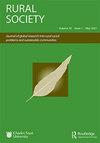Factors affecting population and workforce mobility in Australia: a future of declining regional affinity?
IF 1.1
Q3 SOCIOLOGY
引用次数: 3
Abstract
ABSTRACT An important policy question in Australia is whether regions can attract workforce and population with current policy settings, or whether there are additional social aspects of people’s affinity for regions that may limit migration to regional centres. Using the results of a national household survey, this article tests the extent to which the propensity for internal migration varies between city and metropolitan populations. A series of experiments were used to evaluate the relative importance of factors relevant to relocation or commuting to different types of regional centres, as well as the salary increases required. Only about five percent of the workforce were identified as highly mobile, while more than half of the workforce were not prepared to move no matter what increase in salary is offered. Large salary increases would be required to encourage the “average” employee to move to regional areas, especially from metropolitan locations, with larger salary increases required for long-distance commuting.影响澳大利亚人口和劳动力流动的因素:地区亲和力下降的未来?
澳大利亚的一个重要政策问题是,当前的政策设置是否能够吸引劳动力和人口,或者是否存在其他社会方面的人们对地区的亲和力,可能会限制移民到区域中心。本文利用一项全国家庭调查的结果,测试了城市人口和大都市人口之间的内部迁移倾向差异的程度。采用了一系列实验来评价与搬迁或通勤到不同类型的区域中心有关的因素的相对重要性,以及所需的加薪。只有大约5%的劳动力被认为是高流动性的,而超过一半的劳动力无论加薪多少都不准备搬家。为了鼓励“普通”员工搬到边远地区,特别是从大都市搬到边远地区,需要大幅加薪,因为长途通勤需要更高的加薪。
本文章由计算机程序翻译,如有差异,请以英文原文为准。
求助全文
约1分钟内获得全文
求助全文

 求助内容:
求助内容: 应助结果提醒方式:
应助结果提醒方式:


